As the Oxford English Dictionary has it, ‘collage’ – ‘an abstract form of art in which photographs, pieces of paper, newspaper cuttings, string, etc., are placed in juxtaposition and glued to the pictorial surface; such a work of art’ – is a relatively modern invention. The first usage of the term is traced to 1919, seven years after Pablo Picasso pasted a printed reproduction of a caned chair seat on to one of his paintings and, as established histories go, gave life to a compositional mode that would define avant-garde experimentation from Cubism forwards. ‘Cut and Paste: 400 Years of Collage’ at the Scottish National Gallery of Modern Art works diligently to challenge this narrative; in the process it claims the surprising distinction of being the first survey exhibition of collage ever held. Where scholarly studies and previous exhibitions have tended to focus on collage as a product of high modernist dissatisfaction with artistic tradition, painterly imitation, and the limitations of the two-dimensional image, this exhibition traces a much longer history of layering, arranging, cutting and sticking to celebrate a multifarious art form practiced by professionals and amateurs alike.
Baby (c. 1890), unknown artist. Photo: England & Co, London; © England & Co
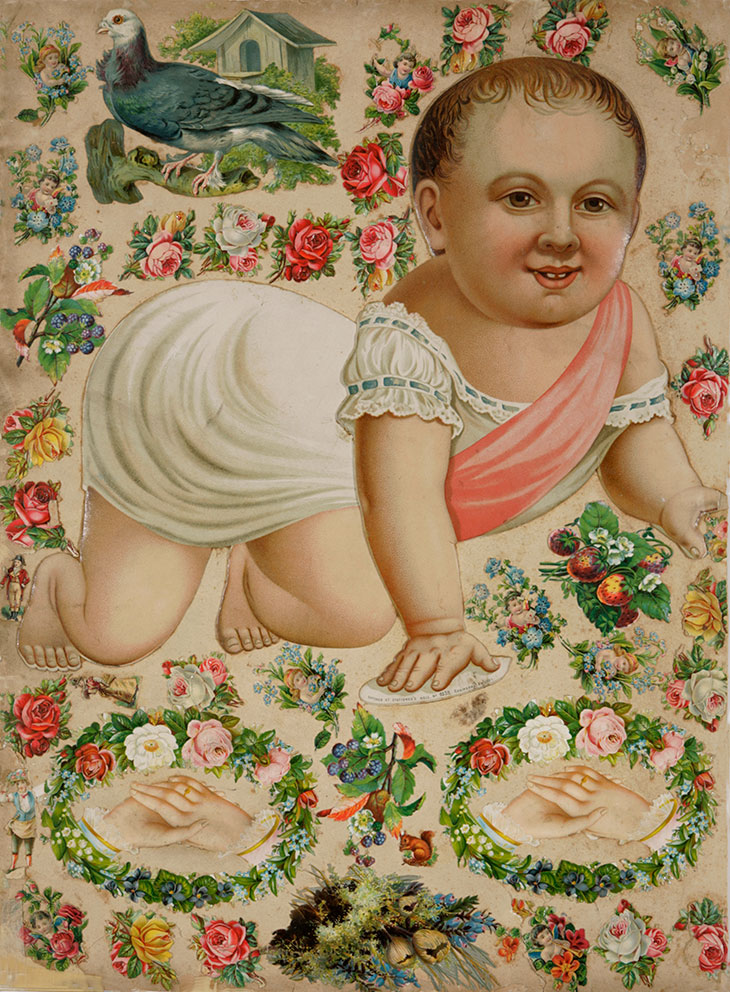
Democratising collage, here, means delving into terminologies and techniques obscured by that term’s long shadow. Familiar collagists from Picasso and Man Ray to Kurt Schwitters and Roland Penrose are pasted into a pre-existing tradition of Victorian scrapbookers, ‘anatomical flap book’ makers, and those private citizens of 19th-century Britain who enjoyed tinsel printing – collecting readymade metal foil ornaments with which to adorn pre-printed engravings of actors, actresses and historical heroes. The exhibition’s first room, dedicated to collage before 1900, gathers together an array of these neglected arts: alongside tinsel printing and scrap work we encounter mosaic work, photomontage, composite photography, and découpage. Collage, we learn, is only rarely found in the old master drawings of the 17th century, and was generally used as a makeshift means of reworking early studies for paintings and prints – as a way, that is, of saving time. The leap into the 19th century reveals the desire for a different sort of temporal tampering: the careful selection and stylised attachment of words, images, and other media enabled artists to construct new chronologies and preserve otherwise fleeting moments.
An imposing scrap-work screen (c. 1860), decorated by Charles Dickens and his friend, the famous Shakespearean actor William Macready, displays almost 400 engravings of actors, actresses, scenes from Shakespeare’s plays, and a portrait of Dickens himself. Neatly trimmed and painstakingly arranged, these collated scraps bespeak the grandeur of the stage; if the screen had its uses as the apparatus of domestic privacy, it also opens out on to the august vista of an artistic tradition to which Dickens stakes his claim. Mortality, rather than celebrity immortality, is Henry Peach Robinson’s concern in the composite photograph Fading Away (1858), which restages the intimate domestic scene surrounding a child’s death from tuberculosis. The artist’s conscientious assembly of five separate glass negatives permits him to orchestrate the play of light and dark. While her father lingers in mournful shadow, the child herself is radiant – almost transcendent – in bright white light, a sign of heaven to come. Elsewhere, among cases of personal scrapbooks and carte-de-visite albums, we find Kate Gough, the daughter of a well-to-do paint manufacturer, using photomontage to create a flippant comment on the major scientific philosophy of her day. High in a leafy bower a family of apes cluster affectionately together; a closer look at their faces reveals this to be a Gough family portrait in which private lives and inheritances are fancifully reimagined in Darwin’s evolutionary terms. As in the works of Dickens and Robinson, Gough’s photo-play produces a vertiginous encounter with time, bringing the personal and intimate into direct confrontation with forces ostensibly beyond individual control. These early uses of collage test the limits of that control in striking ways.
Bottle of Vieux Marc, Glass, Guitar and Newspaper (1913), Pablo Picasso. Tate. © Succession Picasso/DACS 2018
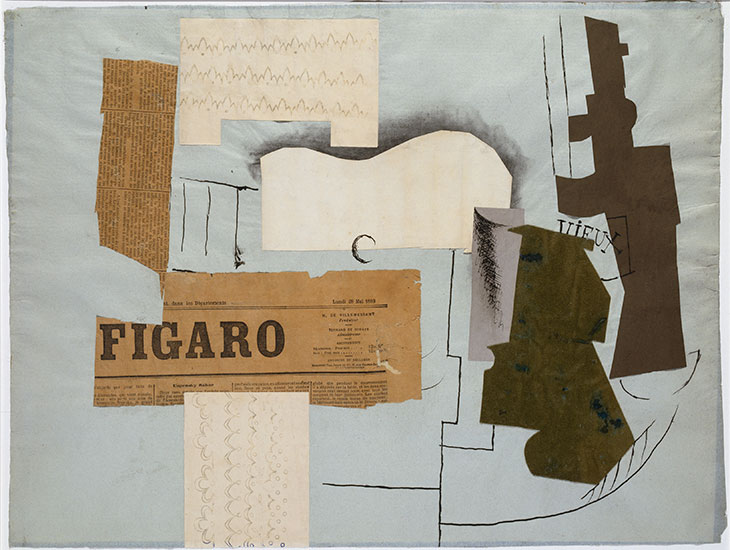
As the wall text observes, we wouldn’t be wrong to identify a kind of proto-Surrealism in experimental works like Kate Gough’s. Indeed, it’s remarkable how often scraps of Victoriana and imitations of older folk art find their way into later collages, especially those of female artists. However, the sheer quantity of works on display means that it can be difficult to catch these visual echoes or to identify a clear narrative as you walk through the space; in a very real sense the exhibition is a collage of its own, and the desire for comprehensiveness threatens to tip the balance between inventiveness and bewildering profusion. Still, a flick through the excellent catalogue may well remedy this narrative issue – and one of the strengths of the show lies in the numerous unexpected pieces included by women involved in the various avant-garde movements of the 1930s and ’40s, an emphasis that complements the museum’s recently opened display ‘Beyond Realism: Dada and Surrealism’ (until 25 October 2020), as well as a burgeoning contemporary interest in the women of Surrealism (as exemplified by White Cube’s ‘Dreamers Awake’ exhibition back in 2017).
Fish Circus (1939), Eileen Agar. National Galleries of Scotland. © The Estate of Eileen Agar. All Rights Reserved 2017/Bridgeman Images
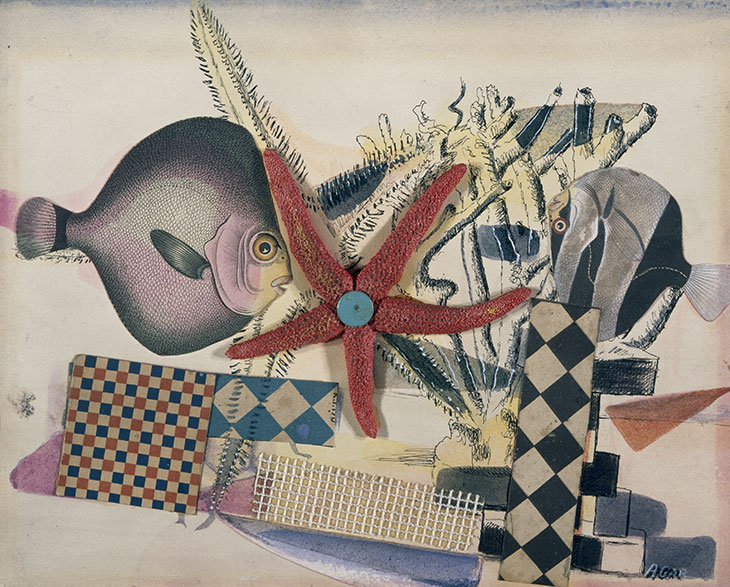
Amid an embarrassment of better-known pieces by Picasso, Edward Burra, Roland Penrose and Eduardo Paolozzi (a little more selectiveness, particularly in the Cubist and Surrealist departments, might have helped to hone the story being told here) we find gems by the Czech Surrealist Toyen, Valentine Penrose, Eileen Agar and Tirzah Garwood. Toyen’s untitled image of a sentimental heroine, who swoons on a beach as a superimposed clock marks the advance of time, tide, and three flying prams, taps into similar concerns with temporality exhibited in the 19th-century works. Here, though, collage also gives us insight into the restrictions and torments of the feminine psyche, refocusing the desires characterised by the disembodied breasts and fetishised torsos of the masculine Surreal we glimpse in works such as Burra’s Collage (1930). Similarly, Valentine Penrose’s appropriation of bits and pieces of old steel engravings in La stratégie militaire (1934) stages its own intervention in traditionally masculine discourses of war, territory, and psychic impulse. Flying into the scene on an ornate Victorian dresser, a statuesque figure hands a piece of a map to a faceless female figure cowering below. As domestic objects and traditions become sites of confrontation or empowerment, so the origins of each scrap these artists stick into their images invoke longer histories of sexism and male dominance. Collage itself – allegedly ‘invented’ by male artists of the day – becomes a medium through which to overturn those hierarchies. Cutting and pasting is a political act and a gendered one. Attending to the histories of its various components can only enhance the force of its statement.
Haywain with Cruise Missiles (1980), Peter Kennard. Victoria and Albert Museum, London
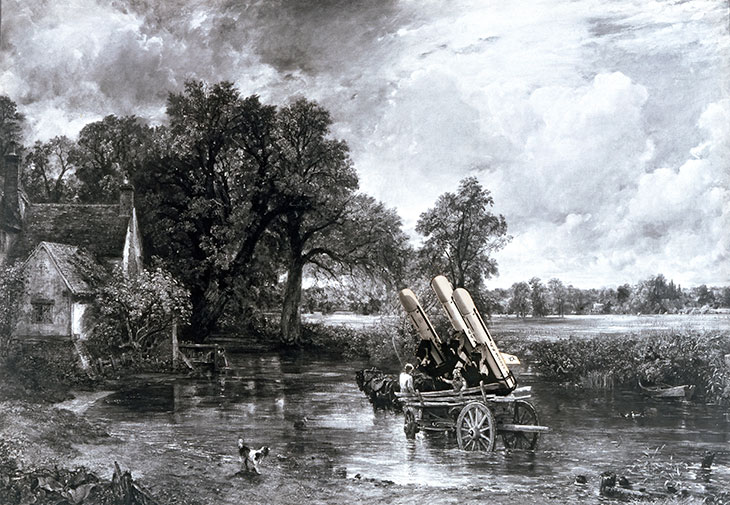
The rest of the exhibition follows this disruptive thread through rooms dedicated to Pop art, political protest of the ’60s and ’70s, and contemporary engagements with the form, which bring the subversive uses of collage to the fore. The Surrealist inheritance is evident here, and pervasive. We find it in the grotesquely mangled, stitched-up bodies and faces of Annegret Soltau’s Schwanger (1978) and GRIMA (1986–97) photomontages; the American projectiles pasted in protest on to Constable’s The Hay Wain (1821) in Peter Kennard’s Haywain with Cruise Missiles (1980); and the wacky world of the unconscious that Terry Gilliam imagined in his TV and film work. These rooms are inevitably heavy with influence and implication, but moments of lightness are to be found in the continued inclusion of amateur artworks. We are treated to the soft fun of fuzzy felt, and a bedroom cupboard door covered with stickers by a young boy, Craig W. Lowe, over the course of his childhood (1987–2000).
This last piece is on loan from Edinburgh’s Museum of Childhood, and its stickers of Snoopy and smiley faces, Mickey Mouse and Dennis the Menace are bound to make any millennial nostalgic. But there are echoes here, too, of Dickens and Macready’s scrap-work screen. As at many other moments throughout this canny exhibition, these visual reverberations serve to form a larger comment about collage and the kinds of self-making it gives individuals of all stripes access to. If Dickens and Macready’s collaboration was a performance for posterity, Craig W. Lowe’s cupboard door is the product of youthful acquisitiveness, of organic creativity, which grew as he did. Political or not, ‘Cut and Paste’ reminds us, the simple act of picking and choosing, snipping and sticking is a formative one: an expression of choice and preference, of a desire to engage in the peculiar, difficult, intensely human art of self-display.
GRIMA – Self with Cat (The Scream) (1986), Annegret Soltau. Courtesy Richard Saltoun Gallery; © DACS 2018
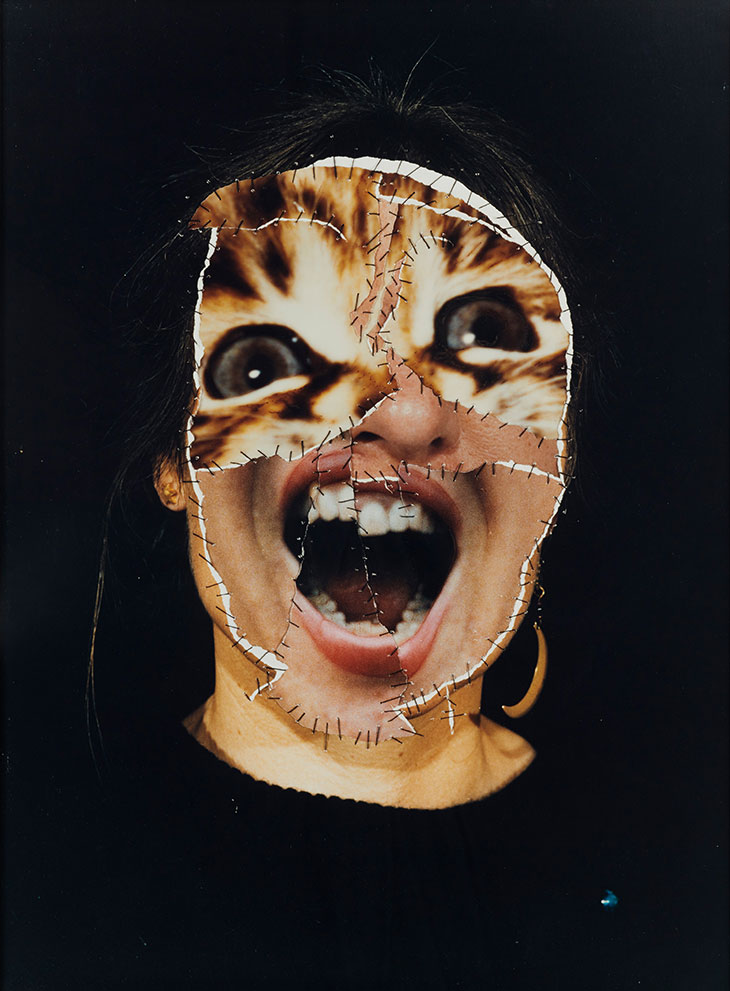
‘Cut and Paste: 400 Years of Collage’ is at the Scottish National Gallery of Modern Art, Edinburgh, until 27 October.



